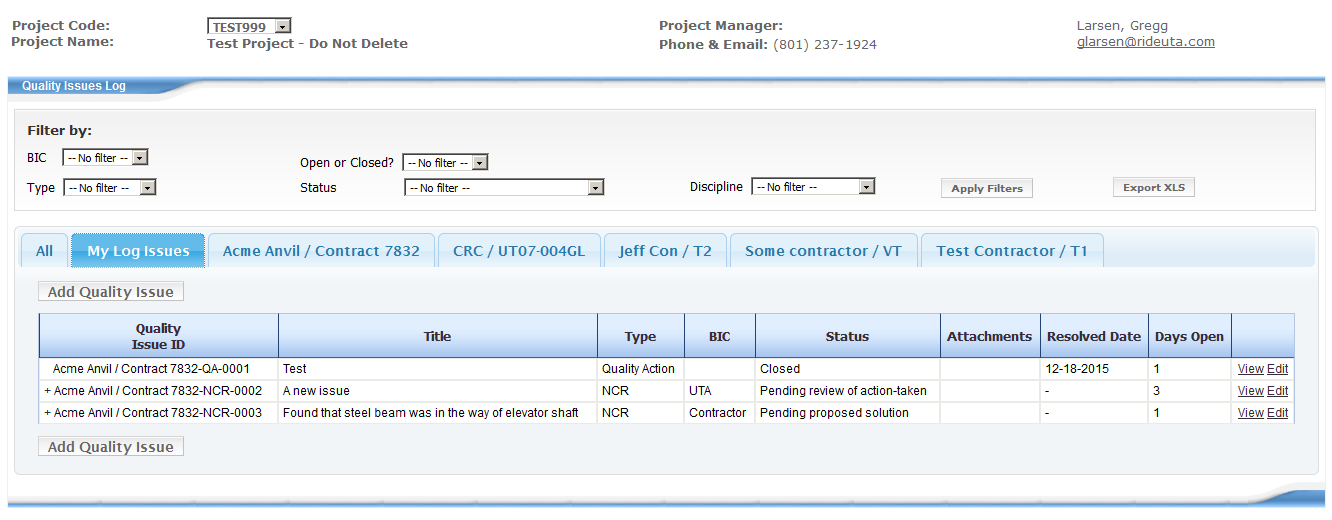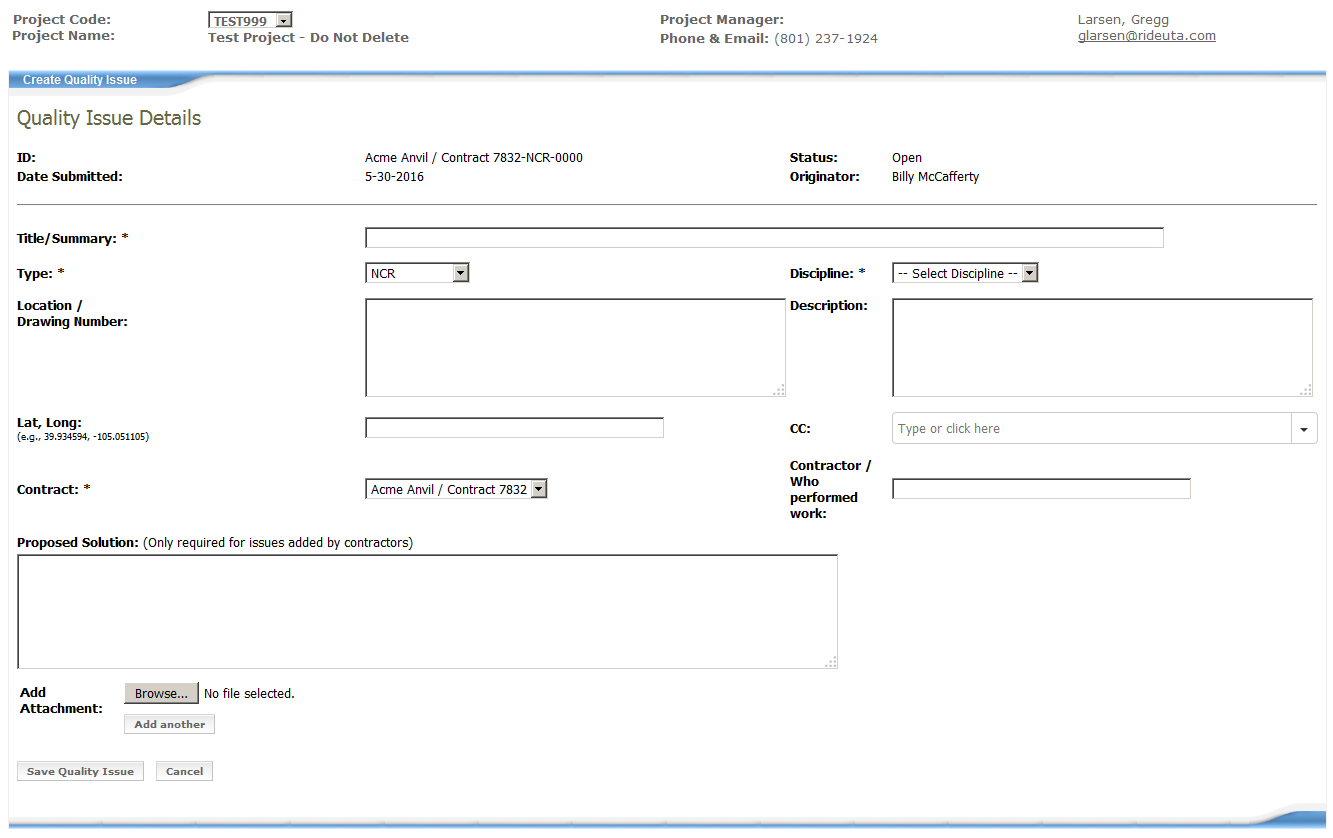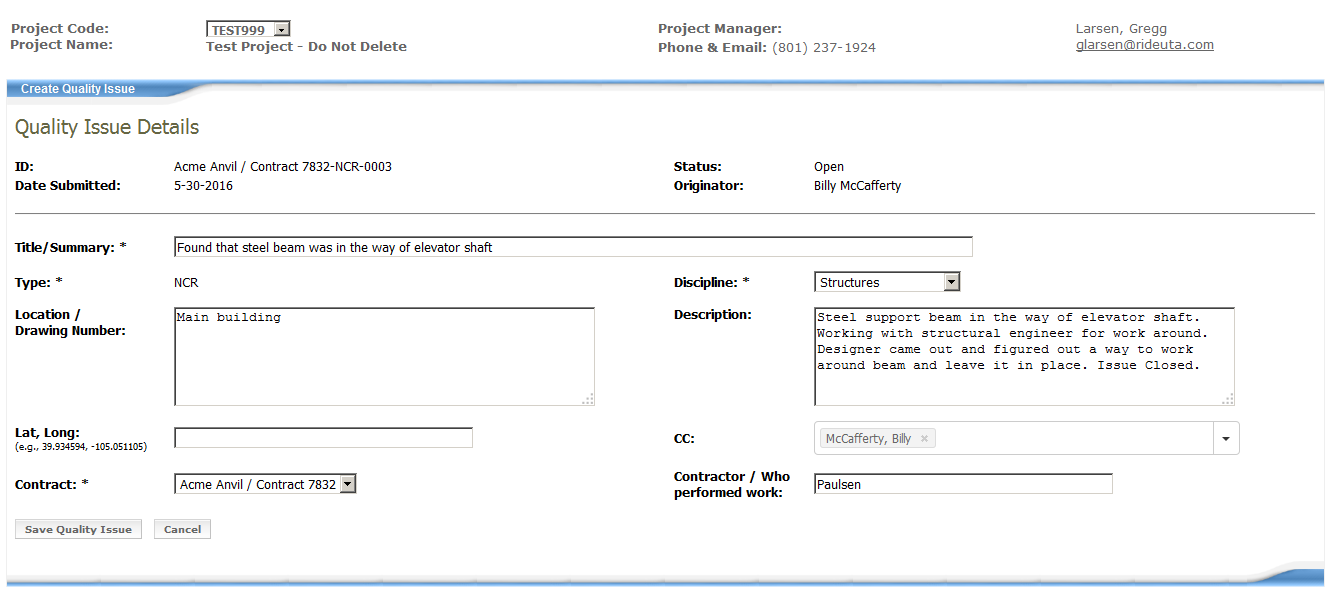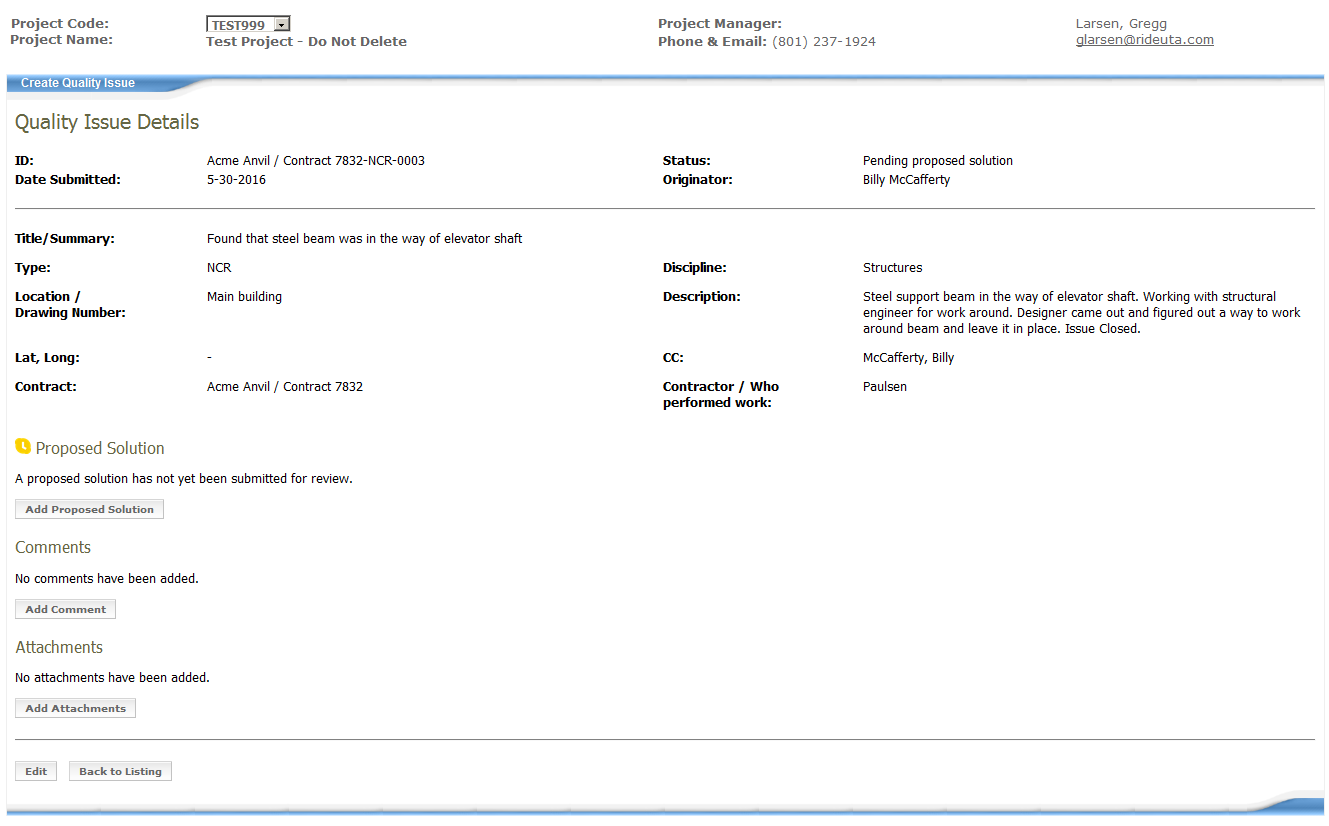
An issue is used to track inspection reports, audits, design audits and other items related to quality control.
An issue contains one or more proposed solutions. Solutions are proposed until one has been approved. At that point, issues can have one or more actions taken to address the issue based on the proposed solution. Once an action is approved, the issue is closed.
Issues, proposed solutions, and actions taken can each have one or more attachments. In addition, quality issues can have one more more comments and each comment can have several attachments themselves.
In the Quality Log area, you can create, edit, and manage quality issues. To get to the main page, select "Quality" from the top menu, followed by "Quality Log" from the secondary menu.
The "Quality Log" page has three main sections within the body. Those are:
From this page, you can manage all aspects of a quality issue, including:
To help the user identify which project they are currently working with, project information has been placed near the top of the page.

You can use the filtering to narrow or broaden the results. By default, all issues are displayed. Users can also export the results of the filtering to excel by clicking on the "Export to Excel" button.

Each contract may have zero or more quality issues associated with it. Each issue has a title, type, and description along with other data. You can add one or more comments to an issue as well. In order to resolve an issue, someone must propose a solution to it and the proposed solution must be approved. Once approved, an action must be recorded against the issue and it also must be approved. At that point, the issue is marked as complete.
Issues are grouped by contract. The tabs at the top of the list reflects this. In addition to tabs for each contract, there is a tab for "My Issues" and one for "All" issues. NOTE: Not everyone has access to view all issues. If you do not have access, you will not see a tab for all issues. "My Issues" are ones in which you are included on the CC list.

By default, "My Issues" is selected. You can choose to view the issues for a specific contract or view all issues. Your tab selection will be remembered the next time you return to the issue listing.
From within the list, you can (depending on your role) create a new issue, view or edit an issue, and manage the proposed solutions and actions taken for an issue.
You can create a new issue in one of two ways:
Both methods will take you to the New Issue page. If you created a new issue from a specific contract tab, that Contract will automatically be selected for the new issue, though you have the option of changing it before you save. If you created a new issue from a different tab, you will be required to select a contract before saving the issue.

On the New Issue page, the following fields are required:
* There are three types of issue to choose from: NCR, Deficiency, and Quality Action. If you select NCR or Deficiency, the Discipline is required. If you select Quality Action, the Discipline field will not appear as it is not relevant for Quality Action issues.
** When contractors of IPCS enter a quality issue, they are required to provide a proposed solution at the time the issue is created. For other users, this field can be left blank and a proposed solution can be added later. Note that proposed solutions do not apply to Quality Action issues, which are closed upon creation.
The CC field lets you enter either an existing IPCS user or an email address. As you type, you will see a list of IPCS users that match the text you entered. You can select from that list or continue typing to enter an email address. Press Enter after you've completed the email address to add it to the CC list.
Adding someone to the CC list for an issue does two things. First, the issue will show up in that user's "My Issues" list. Second, any notifications for the issue (e.g. if a solution is proposed or an action is taken) will be sent to the user.
After completing the appropriate fields, you can add attachments to the issue, then click Save Quality Issue. Alternatively, you can click Cancel to return to the quality issue list without saving the issue.
The View and Edit Issue pages share the same layout and fields with a few key differences. The main difference is that you are able to change the fields for the issue in the Edit page. The exception to this rule is the Issue Type. Once the issue is created, this field can not be changed.

In the View page, you also have the option of adding comments and attachments. For NCR and Deficiency issues, you can also manage the proposed solutions and actions taken from the View page. The reason these actions are allowed on the view page is due to security. Not everyone has permission to edit an issue's core data (e.g. the title, the description, etc.). However, if you have permission to view the issue, you can add comments and attachments and manage the proposed solutions and actions taken. In order to provide everyone with this capability, these features are included on the View page.

Note that quality issues can also be created from a Daily Report. If this is the case, you will see a link to the report that generated this issue on the view page.
Edit - Takes you to the Edit page for the issue
Back to Listing - Takes you back to the issue listing
Add Comment - Allows you to add a comment to the issue. You can also attach one or more files to the comment, if necessary
Add Attachments - Opens a dialog that allows you to attach one or more files to the issue.
Note that you can remove attachments if they are no longer relevant (or if they were added in error). The same is NOT true for comments. Once added, a comment can not be removed or edited. This includes files attached to comments.
Save Quality Issue - Saves your changes to the issue and returns to the issue listing page
Cancel - Discards any changes you've made and returns to the issue listing page
You can manage proposed solutions and actions taken from either the issue listing page or the view page. If you are viewing the issue listing page, click the + next to the issue ID to expand it and manage the proposed solutions and actions taken. The general workflow is:
The workflow above represents the "happy path". The proposed solution may be rejected in step 2, in which case, the issue returns to a state of "Pending a proposed solution" until an alternate solution is proposed. Similarly, an action taken might be rejected (in step 4) and the issue returns to a state of "Pending an action taken".
Regardless of where you manage the proposed solutions and actions taken, you will always see a section for the proposed solution. If the issue has a proposed solution that has been approved, you will also see a section for the action taken. Both sections have an icon next to them indicating whether or not they have an approved item:

An issue in the issue listing page that has not received a proposed solution yet. The yellow icon indicates that this issue
does not yet have a pending proposed solution.

For this issue, the first proposed solution was rejected. The second is awaiting a response.

The same issue seen from the View page. Note that the Action
Taken tab does not appear until there is an approved proposed solution.

An issue in the issue listing page that has an approved proposed solution but no action taken. Note that you can no longer
propose a solution since one has been approved
Some other notes:
The following diagram shows the workflow:

<< Quality: Dashboard | Quality: Systems Testing >>